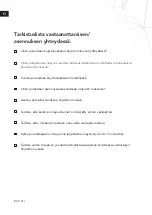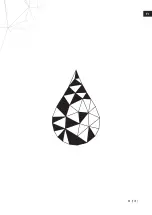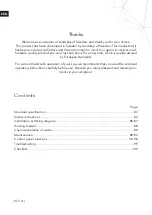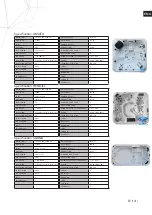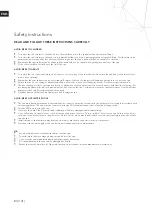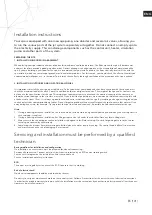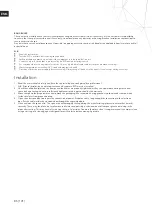
85 (101)
ENG
Installation instructions
Your spa is equipped with one massage pump, one diverter and several air valves, allowing you
to run the various parts of the jet system separately or together. Do not connect an empty spa to
the electricity supply. This can damage components such as the control unit, heater, circulation
pump and other parts of the system.
PREPARING THE SITE
1. INSTALLATION INDOORS/IN A BASEMENT
When placing your spa indoors a number of particular conditions need to be observed. The floor around the spa will become wet
and must therefore provide a good grip when moist. Correct drainage is needed to prevent the accumulation of water around the
spa. If you are building a new room for the spa, we recommend that you install a drain in the floor. Humidity levels will rise with the
spa installed, which can cause fungal growth, mould and other problems. For this reason, you should check the effect of humidity on
exposed wood, wallpaper, etc., in the room. To minimise these effects, thorough ventilation of the area around the spa is advised.
2. INSTALLATION OUTDOORS AND ON PATIOS/BALCONIES
It is important to install the new spa on a stable base. To be certain that your wooden deck or base can cope with the spa you must
check the maximum load of the deck. Consult a qualified builder or designer for advice. The weight of the spa and its contents, can
be found in the specifications for the spa. This weight per square metre must not exceed the nominal capacity of the structure, as
otherwise serious damage to the structure may result. If you install the spa outdoors, we recommend a reinforced concrete plate with
a thickness of at least 10 cm. It is always a good idea to add extra insulation under the spa. By insulating extra against the ground, you
can keep electricity consumption down further. Do not forget to provide sufficient runoff around the spa to ensure that water will run
away during heavy rain, for example. Try to protect the spa from rain and snow and, if possible, build a conservatory for the spa.
Hints
1. If using a housing or sunken installation, the tub should be tested before being housed/lowered to avoid any unnecessary costs in
case servicing is required.
2. If using a housing or sunken installation, flat lifting straps can be left under the tub to facilitate any future lifting work.
3. Always ensure that a housing or sunken installation is designed to facilitate servicing. No costs for gaining access to the tub for
servicing are covered by the warranty.
4. Avoid using the diverter (for water massage selection) when the water pump is running. The control knob is difficult to use when
under pressure and the risk of damaging it is increased.
Servicing and installation must be performed by a qualified
technician.
Basic guidelines for installation and configuration
On installation, an access route must be prepared for when disconnecting.
Permanently connected. Connect only to a circuit that is protected by an RCD and an isolating switch.
See the circuit diagram on the inside of the lid of the control unit.
See the installation and safety instructions.
RCD
The owner must regularly test and reset the RCD to ensure that it is working.
Risk of electric shock!
No electrical components should be maintained by the user.
Do not try to carry out maintenance work on the control system.
Follow all instructions for the owner’s manual electrical connections.
In order for the product warranty to remain valid, the installation must be carried out by an authorised electrician and all earth connec-
tions must be installed correctly.
Summary of Contents for AMIATA Vital +
Page 21: ...21 101 SE...
Page 41: ...41 101 DK...
Page 61: ...61 101 NO...
Page 81: ...81 101 FI...
Page 101: ...101 101 ENG...










